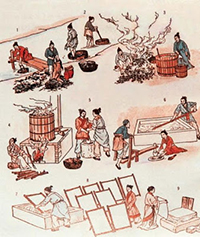
March 11 can be considered a landmark date for all book lovers. According to Chinese chronicles, it was on this day in 105 A.D. that Cai Lun, a Chinese dignitary of the Han Dynasty, obtained paper from bamboo fibers. Before that, paper in China was made from hemp, and even earlier from silk, which was made from defective silkworm cocoons.
Cai Lun, on the other hand, crushed mulberry fibers, wood ash, rags and hemp. He mixed all this with water and put the resulting mass on a mold (wooden frame and bamboo sieve). After drying in the sun he smoothed the mass with stones. The result was sturdy sheets of paper.
When Cai Lun presented his paper-making process to the emperor, he was very pleased with the result and immediately granted him a high title and wealth, and issued a decree according to which the paper-making process was to be widely distributed throughout China. Thus, Chinese civilization began to develop rapidly, especially in the fields of literature, education and paperwork.
After the invention of Cai Lun, the paper-making process began to improve rapidly. Starch, glue, natural dyes, etc. were added to increase strength.
From China, already in the 6th century, the recipe for making paper spread to Japan and then to other Asian countries. In VII century, after the victory of the Arabs over the Chinese, the secret of making paper became known in the Middle East. The city of Samarkand, became a kind of center of the paper industry in the region. In XI-XIII century, the secret got into Europe. First in France, Italy and Spain. From them, the production of paper, was distributed to other countries in Europe.

Cai Lun's paper-making technology was a new milestone in the development of human civilization. According to historical records, Europe built a paper factory only 1,000 years after Cai Lun invented it. Although the paper industry is now well developed, it still takes the principle of making paper invented by Cai Lun as its starting point.
MekezhanovYerassyl, librarian of the Department of the International Book

